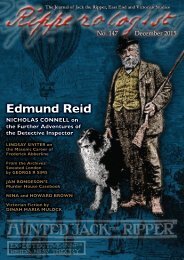GEORGE HUTCHINSON
orxwju5
orxwju5
Create successful ePaper yourself
Turn your PDF publications into a flip-book with our unique Google optimized e-Paper software.
C R<br />
I M E<br />
The Crime Museum<br />
Some years ago I stood with Gordon Honeycombe, who died in October of this year, eating canapés and drinking a<br />
glass of wine amid the relics of heinous crime in Scotland Yard’s internationally famous Black Museum, as the Crime<br />
Museum was still popularly known. Honeycombe had written The Murders of the Black Museum (1982), and we were<br />
both at the Black to extend our good wishes on the retirement of curator, Bill Waddell (who in 1993 would write his own<br />
book about the place, The Black Museum). I don’t think I have been to a party in a stranger venue. Happy days.<br />
The Crime Museum Uncovered:<br />
Inside Scotland Yard’s Special Collection<br />
Jackie KeIly and Julia Hoffbrand<br />
London: I.B. Taurus, 2015<br />
www.ibtauris.com<br />
ISBN: 9781781300411<br />
softcover; 192pp; illus;<br />
£12.99<br />
‘Money cannot purchase access to it, and curious visitors are only admitted on orders signed by<br />
senior executive officials who know them personally. For the museum contains too many of the<br />
secrets of crime to be a wholesome place for the general public…’<br />
So wrote George Dilnot in a chapter devoted to the Black Museum in his book Scotland Yard: The Methods and<br />
Organisation of the Metropolitan Police. Dilnot was writing 100 years ago, but you still can’t buy a ticket to the Black<br />
Museum. But you can buy the next best thing - from 9 October 2015 until 10 April 2016 the Museum of London is hosting<br />
an exhibition of objects from the Crime Museum. I’d love to visit the exhibition, but unfortunately I won’t be able to,<br />
but the accompanying book, The Crime Museum Uncovered, is an absolute cracker.<br />
It’s written by Jackie Keily and Julia Hoffbrand, who curated the exhibition in partnership with the Metropolitan<br />
Police Service and the Mayor’s Office for Policing and Crime. Hoffbrand had previously curated the excellent Jack the<br />
Ripper exhibition at the Docklands Museum. The book discusses over four hundred carefully selected objects recalling<br />
some of Britain’s most notorious crimes, including the Great Train Robbery, the Kray twins, and the Millennium Dome<br />
diamond heist. There are nearly five hundred illustrations.<br />
The book is divided into three sections, The Early Crime Museum, Individual Cases, and Themes.<br />
The Early Crime Museum opens with an illustration of the visitors’ book, two interesting visitors being John Moore and<br />
Tom Bullen of the Central News Agency. They visited on 26 July 1892 and may well have seen the ‘Dear Boss’ letter which<br />
gave the world the name ‘Jack the Ripper’ and which may have been conceived and written by one or both these men.<br />
The facsimile of the ‘Dear Boss’ is pictured, as is a copy of ‘Illustrated Circular, No. 76’ dating from 1905 and showing<br />
a picture of ‘John Evest’, otherwise Michael Ostrog. This is a fascinating discovery of Ostrog in later life.<br />
There are pictures of several death masks and the ropes used to hang various murderers, including the rope used to<br />
hang Mary Pearcey. Pictures of weapons include the knife use by Richard Prince who murdered William Terriss and the<br />
gun used by Edward Oxford in his ridiculous and half-hearted attempt to assassinate Queen Victoria.<br />
Individual cases include the Stratton Brothers, Dr Crippen, the Siege of Sidney Street, Gordon Cummins (the so-called<br />
Blackout Ripper), Neville Heath, John Haigh, Charlie and Eddie Richardson, and, inevitably, Ronald and Reginald Kray.<br />
Ripperologist 146 October 2015 88




